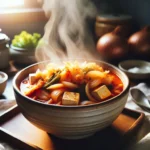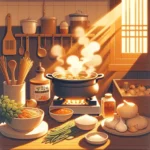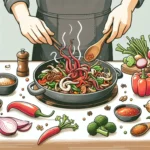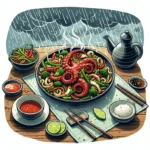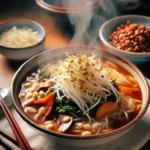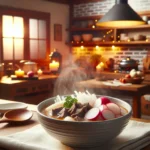As the cold winds of winter approach, nothing warms the heart quite like a steaming bowl of authentic Korean soft tofu stew, or sundubu jjigae. This delectable dish, brimming with rich flavors and soothing ingredients, invites you on a culinary journey that engages all your senses. Picture yourself savoring the delicate texture of the soft tofu, perfectly paired with spicy seasonings and fresh vegetables. It’s a dish that not only nourishes your body but also brings comfort to your soul. Join me as we unravel the secrets of this beloved dish, exploring its ingredients, cooking methods, and tips to elevate your sundubu jjigae to perfection. Let’s embark on this flavorful adventure together!

Ingredients Needed for Sundubu Jjigae
To create the exquisite and heartwarming soup that is Sundubu Jjigae, one must gather a selection of fresh and flavorful ingredients. This authentic Korean soft tofu stew stimulates the senses! 🌶️ But what exactly do you need? Let’s break it down step by step to ensure your culinary quest is successful!
1. Soft Tofu (Sundubu)
This is the star of the dish! You’ll need about 300-400 grams of unadulterated soft tofu. It’s delicate, creamy, and oh-so-delicious. The quality of tofu can really make or break the stew, so don’t skimp on this vital ingredient!!
2. Broth
Traditional Sundubu Jjigae usually calls for a rich broth. You can opt for 2-3 cups of anchovy broth, which is ideal for heightening the umami flavor. If you’re a vegetarian, consider using vegetable broth as a great alternative, with the same quantity.
3. Protein Options
Adding meat (or a vegetarian substitute!) into your stew can elevate the flavor of the dish dramatically! Typically, 100-200 grams of thinly sliced pork or beef is used. Alternatively, you could use seafood, such as clams or shrimp for a refreshing touch! 🦐
4. Kimchi
About ½ cup of well-fermented kimchi adds a spicy, tangy element that’s simply irresistible! It not only contributes flavor but also has health benefits due to its probiotics!
5. Vegetables
Incorporating vegetables brings freshness and texture! You might choose to add ½ cup of diced zucchini, 1 small onion (sliced), and a few mushrooms (like shiitake or oyster) for an aromatic enhancement! 🥒
6. Seasoning
This is where the magic truly happens! Start with 2-3 tablespoons of gochugaru (Korean red chili flakes) for the quintessential heat. For savory notes, include 1 tablespoon of soy sauce and optionally, a drizzle of sesame oil for a toasty finish!
7. Eggs
To add richness and a delightful texture, consider dropping in one whole egg towards the end of cooking! It creates a creamy finish to each bowl, and who doesn’t love an egg in their stew? 🤤
8. Garnish
Don’t forget the finishing touches! A sprinkle of sliced green onions and a dash of sesame seeds can elevate your dish to a visual masterpiece! 🌱
As you gather these ingredients, remember that freshness is key for achieving the best flavor possible! Each component plays an integral role in the overall harmony of Sundubu Jjigae, from the spiciness of the gochugaru to the creaminess of the tofu. With these ingredients at your fingertips, you’re well on your way to crafting your own delightful bowl of this beloved Korean comfort food! 🥘✨
Step-by-Step Cooking Instructions
Creating authentic Sundubu Jjigae can be an adventure of flavors! Let’s dive into the culinary journey to craft this delicious Korean soft tofu stew that will warm your heart. Are you ready? Let’s get cooking!
1. Prepare Your Ingredients:
The first step is to gather all your ingredients. You’ll need a sturdy base of about 1 tablespoon of vegetable oil, 1 medium onion (finely chopped), and 1-2 tablespoons of gochugaru (Korean red pepper flakes) to infuse that signature spiciness! Don’t forget 3-4 cloves of garlic, minced for aromatic depth! Also, consider 200g of your choice of protein—silken tofu is crucial, so grab 1-1.5 cups of soft or silken tofu! 🌶️
2. Sauté the Aromatics:
In a medium pot, heat the vegetable oil over medium heat. Once it shimmers, toss in the chopped onions and sauté them for about 3-5 minutes until they’re translucent. The kitchen should start smelling heavenly! Next, add the minced garlic and gochugaru; stir them together for another minute — this step is what makes your sundubu jjigae unforgettable!
3. Add Your Broth:
Now it’s time for the magic! Pour in 4 cups of fresh anchovy or vegetable broth. If using anchovy broth, make sure to strain it for a smooth finish. Bring the broth to a simmer, allowing the flavors to meld beautifully together. Can you hear that satisfying bubbling? 😊
4. Introduce the Tofu and Protein:
Once the broth is simmering, carefully add your protein (like seafood or beef) and cut the silken tofu into bite-sized chunks. Gently stir them in to avoid breaking the tofu! Give it about 5-7 minutes to allow the tofu to absorb that delicious broth flavor. How exciting is that?! 😋
5. Season to Taste:
At this stage, it’s all about the seasoning! Add about 1 tablespoon of soy sauce for umami and adjust the seasoning based on your preference. If you like it spicier, feel free to add more gochugaru! Taste everything — this is where your personal touch shines! 🎨
6. Final Touches:
For the final flourish, throw in a handful of green onions sliced finely, and if you’re feeling adventurous, a raw egg right into the bubbling stew. The egg will cook gently in the heat, enriching the stew even further. It’s time to let this simmer for an additional 3-5 minutes.
7. Serve Immediately:
Sundubu Jjigae is best enjoyed hot and fresh! Transfer the stew into individual bowls, making sure to get those tofu chunks and protein. Sides of steamed rice and maybe a sprinkle of sesame oil on top can elevate your experience even more! 🍚
Throughout this process, every ingredient plays a crucial role! From the garlic’s aromatic burst to the creamy texture of the tofu, each moment will lead to a sumptuous dish that embraces comfort and warmth.
The beauty of Sundubu Jjigae lies not just in its deliciousness but in the simple joy of creation. Just imagine, with each bite, you’re savoring a piece of Korean tradition! So put on that apron and go ahead—let your culinary masterpiece bring happiness to your dining table! 🍽️✨
Tips for Achieving the Perfect Flavor
Creating an authentic Bang for the Taste Buds in your Sundubu Jjigae requires more than just tossing ingredients into a pot. The key lies in a symphony of flavors where each component plays a crucial role, ensuring that your stew will tantalize the senses. 🌶️
Choosing Gochugaru
First and foremost, the choice of gochugaru (Korean red pepper flakes) is vital. A high-quality gochugaru will lend its signature deep red hue and smokiness to your stew. Aim for a coarsely ground variety—roughly 2 tablespoons will work wonders. If you prefer a tad more heat, don’t hesitate to adjust the quantity! Just remember, achieving that perfect balance is what sets an ordinary Sundubu Jjigae apart from the extraordinary! 🌟
Preparing the Broth
Next, consider the broth. The base of your stew should be homemade stock to achieve an unparalleled depth of flavor. Simmering anchovies with dried kelp for about 20 minutes can yield a robust umami-packed broth. Alternatively, a chicken stock or vegetable broth can be used, depending on your preference. Make sure to strain the stock well to avoid any unwanted bits floating around! 🌊
Adding Tofu
When it’s time to introduce tofu, the texture and freshness of your soft tofu (sundubu) are essential. Consider sourcing silken tofu from your local Korean market for optimal results, as its delicate texture combined with the gentle heat from your stew creates an exquisite mouthfeel. Using about 400 grams should be just right for a hearty stew!
Enhancing with Aromatics
Another integral aspect is the aromatics. Sautéing minced garlic (about 3 cloves) and sliced onions at the beginning not only builds flavor but also adds a fragrant base to your stew. Onions should be caramelized until they are translucent; trust me, this small detail makes a world of difference! 🧄✨
Seasoning Your Stew
Now, let’s not overlook the seasoning! Adding soy sauce (approximately 2 tablespoons) enhances the umami experience, while a touch of sesame oil (1 tablespoon) right before serving adds richness and complexity. Finishing your stew with a sprinkle of chopped scallions and a dash of sesame seeds elevates the presentation and adds that gourmet touch.
Balancing Spice Levels
It can’t be ignored that balancing the spice level leads to the perfect flavor. Is it too spicy? Too bland? Adjust the seasoning with the patience of a Samurai! Use sugar as a secret weapon, if necessary, to mellow intense flavors. Just a teaspoon might be all you need, but watch it closely—you’re aiming for harmony, not sweetness! ⚖️
Favoring Fresh Ingredients
Finally, favoring fresh ingredients elevates your Sundubu Jjigae dramatically. Try incorporating seasonal greens like bok choy or zucchini for added texture and flavor. The vibrant colors make your dish more appetizing and nutrition-packed—a feast for both the eyes and the palate! 🥬🌈
In summary, from sourcing the finest ingredients to carefully balancing flavors, each step is pivotal in crafting your perfect Sundubu Jjigae. Patience and a bit of creativity will lead you there! Enjoy the artistry of your cooking and allow these tips to guide you towards a culinary masterpiece each time you prepare this beloved Korean dish! 🍲❤️
Serving Suggestions and Pairing Options
When it comes to serving Sundubu Jjigae, the delightful soft tofu stew deserves an equally delightful presentation! This dish is not only renowned for its rich flavors but also for its versatility in pairing with a variety of side dishes. Have you ever considered what makes the meal complete?
Traditional Accompaniments
Starting with the traditional accompaniments, steamed white rice is a staple that complements the hearty nature of Sundubu Jjigae beautifully. The rice serves as a fantastic canvas, absorbing the spicy, savory broth of the stew. Depending on your preferences, a serving of ~1 cup (approximately 200 grams) of rice per person is a recommended portion that balances the meal perfectly. 🍚
Crunchy Additions
For those who enjoy adding a bit of crunch, kimchi is an absolute must! The fermented vegetables provide not only a great contrast in texture but also an explosion of flavors that elevate the stew’s taste. Try various types of kimchi – from napa cabbage to radish – as they each bring their unique zing. It’s fascinating to note that in Korea, there are over 200 varieties of kimchi! 🌶️
Culinary Enhancements
If you wish to enhance your culinary experience further, consider pajeon (Korean scallion pancake) as an exciting option! This crispy pancake, filled with chopped scallions, offers a delightful bite that harmonizes with the steamy stew. Pairing these two might just make your day feel special. Each pajeon slice could be about 100 grams, creating a wonderful contrast with the softness of the tofu.
Beverage Pairings
Now, let’s not forget about the beverages! Serving a chilled glass of makgeolli (Korean rice wine) can add a refreshing twist to the meal. With its slightly sweet and tangy profile, makgeolli pairs exceptionally well with robust flavors like those found in Sundubu Jjigae. Alternatively, you could go for a glass of soju, renowned for its clean finish and ability to enhance the meal’s spiciness. 🍶
Non-Alcoholic Options
If you’re in the mood for something non-alcoholic, why not try a barley tea? This nutty-flavored tea not only soothes the palate but is also known for its digestive benefits, making it an excellent choice alongside the hearty stew!
Creative Sides
Finally, don’t overlook the potential of adding a side of Korean-style pickles. These often include cucumbers or radishes marinated in sweet and spicy sauces, which can revamp the flavor profile and cleanse the palate between bites. It’s a culinary experience filled with artistry and creativity, wouldn’t you agree?
Serving your Sundubu Jjigae with these delightful pairings will surely create a memorable dining experience that captivates the heart and palate alike. The combination of textures, flavors, and vibrant presentations not only enhances your meal but also transports you to the bustling streets of Korea with every bite. Isn’t it amazing how food can connect us to cultures and memories? 😍✨
As you embark on your journey to create the delightful Sundubu Jjigae, remember that every simmering pot holds a story waiting to be savored. This dish, rich in tradition and bursting with flavors, invites you to relish each moment of preparation. Embrace the process, for the secret to authenticity lies not just in ingredients but also in the love and care infused into every step.
Allow your senses to guide you, experimenting and adjusting to discover your personal twist on this beloved classic. Whether enjoyed alone or accompanied by friends, the warmth of Sundubu Jjigae transcends mere sustenance—it becomes an experience. Dive in, unleash your culinary creativity, and let’s transform simple ingredients into a heartwarming masterpiece. Happy cooking!
